Barking Town Urban District Council Tramways
History
Barking Town Urban District Council obtained powers to be build a 1.23-mile long standard gauge electric tramway on the 13th February 1898; the powers were granted under the Barking and Beckton Light Railways Order of 1898, Barking reputedly being the first urban district council to obtain such an order. The tramway was primarily intended to provide a modern means of transport between Barking and Beckton Gas Works, where many of the populace found employment; the line was notable for crossing Barking Creek (the River Roding) by means of a bascule bridge (of which Tower Bridge is perhaps the most famous example). Before the main north-south line was opened, additional powers were acquired to build lines from Barking that would connect with the neighbouring systems of East Ham to the east, and Ilford to the north; these were granted on the 26th March under the Barking Light Railways (Extensions) Order of 1903. Even with the additional lines, which took the total authorised mileage to circa 2.57 miles, it is difficult to see how such a short length of tramway could have been operated profitably and independently.
The first electric services, between Beckton and the south side of the bascule bridge — which was not finished at the time — commenced on the 1st December 1903. The route northwards from the bascule bridge to Barking was opened two weeks later on the 15th December 1903, with permission to operate the bascule bridge being granted on the 4th February 1904.
On the 7th June 1904, the existing line was joined by an extension to the northeast to meet with Ilford Council Tramways' line at Loxford Bridge; however, because the London, Tilbury and Southend Railway had yet to build their promised road overbridge at Barking Station, the new line was not physically connected to the Beckton line (where the tram depot was situated), so it was for the time being leased to the ICT. A similar approach was taken to the west, where it was agreed that a new line from Barking Station to the East Ham boundary in London Road would be operated by a joint service provided by East Ham Corporation Tramways and West Ham Corporation Tramways; this line was opened on the 17th November 1905.
The three separate lines were finally joined up in July 1907, with the completion of new track and the bridge over the railway at Barking Station. Although Ilford Council Tramways continued to work the Loxford Bridge line for a few more months, operation was eventually taken over by Barking on the 1st September 1907. A further change to the services on this route was brought into effect three years later (on the 17th November 1910), when Barking, East Ham and West Ham agreed to operate a joint service between Loxford Bridge in the east and Poplar in the west. When this service was extended even further westwards over London County Council Tramways tracks from Poplar to Aldgate — on the 20th September 1912 — the LCCT also joined the joint-running agreement.
Unfortunately, Barking now found itself with a minority share in its one profit-making route, whilst operating the loss-making Beckton line by itself. The council therefore withdrew from the agreement on the 31st May 1914, leasing the Loxford Bridge to Barking Broadway line to Ilford Corporation Tramways, and the Barking Broadway to London Road line to East Ham Corporation Tramways. No doubt the council hoped to return the tramways to profitability, but this was not to be, as significant investment was needed to repair the bascule bridge, and to replace worn-out track after the low-maintenance of the Great War years.
Following the construction of Barking Bypass, the Council reached agreement with the London General Omnibus Company for them to run a bus service to Beckton, which resulted in closure of the Beckton line on the 16th February 1929. From this time on, although Barking was still a tramway owner, it was no longer an operator, as the services to the east and the west over Barking's remaining tracks were provided by Ilford and East Ham, respectively.
The aforementioned lines — along with 13 other London tramway systems — passed to the newly created London Passenger Transport Board on the 1st July 1933.
The last tram service of all over former BTUDCT tracks, operated by the LPTB, ran on the 8th June 1940.
Uniforms
Unfortunately, photographs depicting crews and staff of Barking's rather ill-fated system are extremely rare, so what follows can only be described as tentative. Motormen appear to have worn single-breasted jackets with five buttons (bearing the full system title and a depiction of the town's Firebell Gate - see link), two breast pockets (with button closures), epaulettes and stand-up collars; it is currently unclear what insignia, if any, were carried on either the epaulettes or the collars. Conductors wore double-breasted, lancer-style tunics with five pairs of buttons (narrowing from top to bottom). The uniforms were apparently of blue serge with red piping. The tensioned-crown peaked caps bore standard, 'off-the-shelf', script-lettering grade badge — either Motorman or Conductor — above which a round cap badge was worn; the latter bore the full system title — 'Barking Town U.D.C. Tramways' — around a representation of Barking Abbey's Firebell Gate. The buttons and insignia were brass.
In later years, the script-lettering grade badges fell out of use, and as the system struggled financially, uniform policy became ever more relaxed, crews often appearing in flat caps rather than the standard-issue tensioned-crown peaked caps.
Tramcar staff were also provided with double-breasted greatcoats with high, fold-over collars and epaulettes; the latter appear to have borne insignia of some kind, though precisely what remains unclear.
Motormen and conductors always appeared in service wearing enamel Public Carriage Office licences issued by the Metropolitan Police (see link).
Photographs of inspectors are yet to come to light, so there is currently no information available on their uniforms. The situation with female staff, who may have been employed during the Great War to replace male staff lost to the armed services, is also unclear, with neither documentary nor photographic evidence available to confirm this.
Further reading
For a history of the system, see: 'The Tramways of East London' by Rodinglea; The Tramway & Light Railway Society and The Light Railway Transport League (1967).
Images
Motormen and conductors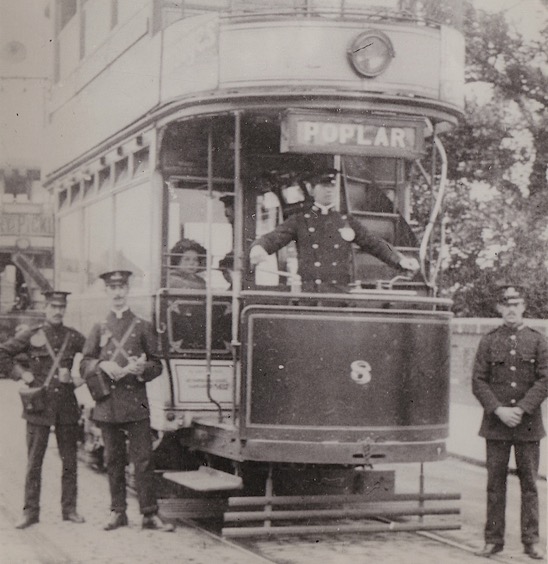
Barking Tramcar No 8 at Loxford Bridge, with an Ilford Council Tramways vehicle in the background — photo undated, but probably taken around 1912. The photograph probably depicts a crew from each system, with the Barking crew being second from the left (conductor) and extreme right (motorman); this is based on the fact that they clearly have a round badge above their script-lettering grade badges, unlike Ilford, whose crew caps simply bore script-lettering grade badges (see link). If correct, this would mean that the individual at the helm of No 8 is actually an Ilford motorman, which was probably a switch done for the benefit of the cameraman, or the crews' amusement. Photo courtesy of the Tramways and Light Railway Society, with thanks to Eddie Dawes.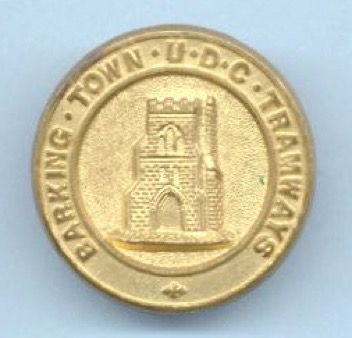
Barking Town UDC Tramways cap badge, with Barking Abbey's Firebell Gate in the centre — brass.
Standard ‘off the shelf’, script-lettering cap badges of the type used by Barking UDC Tramways — brass. Author's Collection.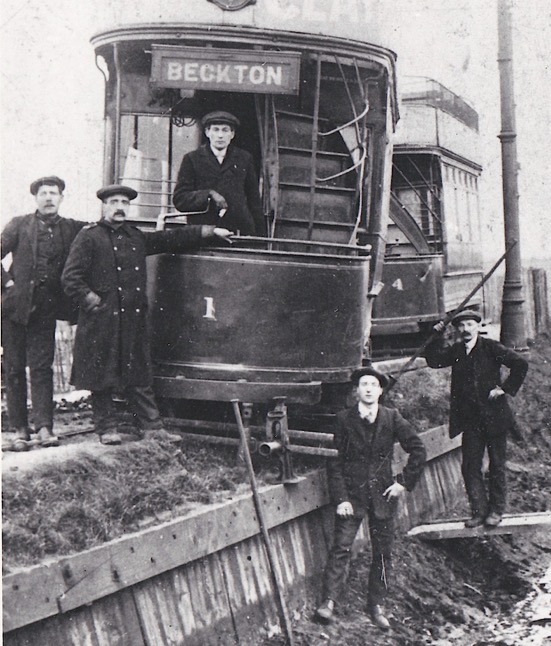
An errant Tramcar No 1, with Tramcar No 4 behind, pictured in Jenkins Lane — photo undated, but possibly taken around 1910/11. The rescue team are very probably depot maintenance staff, though one (second from left) is clearly wearing a tramcar crewman's greatcoat. Photo courtesy of the Tramways and Light Railway Society, with thanks to Eddie Dawes.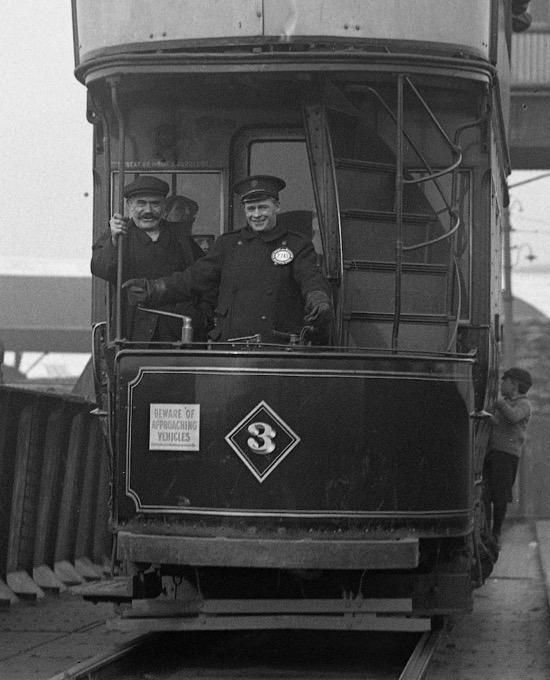
Barking Town UDC Tramways No 3 negotiates the Bascule Bridge on the 3rd November 1928. Photo by Dr H Nicol, courtesy of the National Tramway Museum. 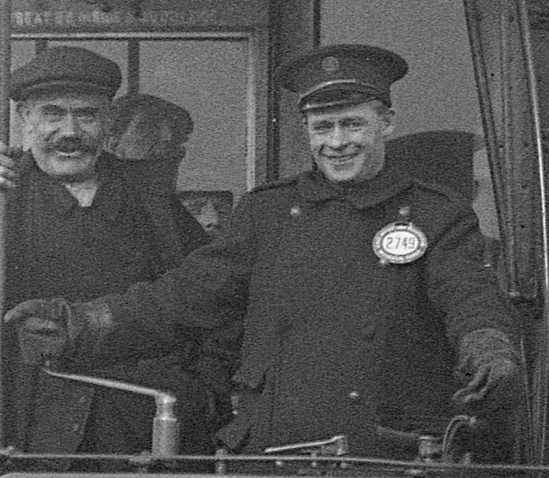
An enlargement of the above photograph showing the motorman, who is wearing the standard, round, municipal cap badge, but without a script-lettering grade badge; his PCO licence is No 2749 'Stage Driver and Conductor — Mechanical Power'.